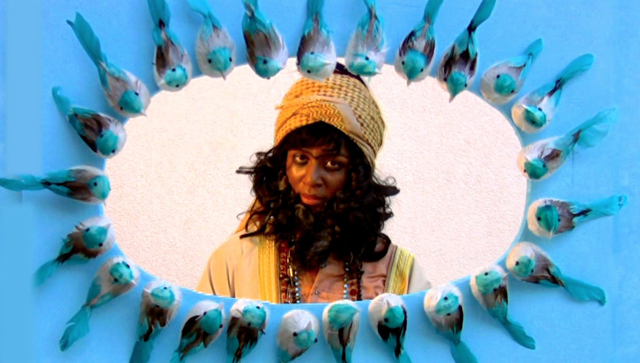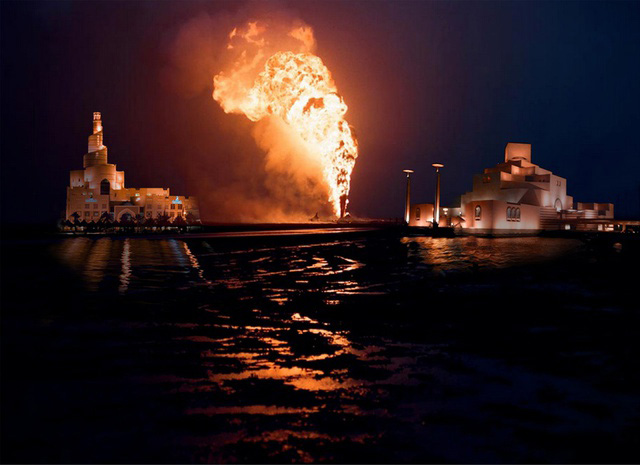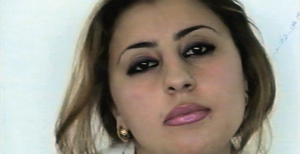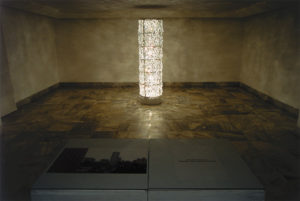Monira Al Qadiri’s socio-ethnic study of affect is central to her work. Often looking at themes connected to mass media, sadness, and what the Beirut-based artist calls “masculine narcissism,” much of her art –produced both in the Middle East and during her 10 years studying in Japan –explores the political contrast between East and West, and how different emotions are portrayed and valorised.
A founding member of eight-strong Gulf art collective GCC, Al Qadiri is speaking to me over Skype from her flat in the Lebanese capital, where she’s been living for the last three years. She’s just returned from New York where the group are showing at the New Museum’s Here and Elsewhere, a bit jetlagged, but still happy to discuss her work.
Her recently launched video called ‘Soap’ (2014) for Creative Time Reports manipulates footage from soap operas shown in the Gulf region, and inserts a crucial missing figure: the migrant worker. Al Qadiri tells me that nearly everyone in Kuwait has hired help, due to excessive wealth, but these TV shows depict a very different reality: one where families cook for themselves during Ramadan, and the maid is entirely absent. She looks at the exported image of Kuwaitis, compared to the real situation on the ground.
Al Qadiri moved to Beirut for an artist residency at Ashkal Alwan three years ago, and says the reason she never left was because “the art scene here is so advanced, probably the most advanced in the Arab world.” The volatile political situation in the region is not an unfamiliar one, particularly for an artist who grew up in Kuwait during the First Gulf War. A lot of her artistic practice and research focuses on understanding conflict, through a framework of pre- and post-oil historical understanding. Her colourful, raw and, at times, comical videos deal with sadness and tragedy as an everyday occurrence in the Middle East, all of which comes through clearly in her expert use of costume and set design to create a complete visual experience as something she calls “total art.”
Your work often focuses on the theme of sadness in the Middle East, displayed usually by a masculine character who you portray. You deal with issues of narcissism – I’m interested in why it has to be the male character for you?
Monira Al Qadiri: I was living in Japan for a long time and I was thinking about how Western culture is saturated with this oppressive happiness. But, for example, in the Arab world – even in Iran and Turkey – sadness is seen as something noble and beautiful. A lot of poetry and songs are all about sadness and loneliness. It’s always about this tragic character, and it’s very narcissistic. So sadness isn’t seen as an illness or a disease. It’s seen as something beautiful and almost self-indulgent. I was thinking about that a lot and then I decided to research it. My doctoral dissertation was called ‘The Aesthetics of Sadness in the Middle East’. I thought that the best thing to represent this aesthetic is music and songs from the region, so I decided to create a lot of music videos using these masculine characters.
I think of melancholy and narcissism as having a direct relationship. Then I thought what is narcissism to me: narcissism is something masculine. I don’t know why that came up in my life. I think it came up during the war in Kuwait. I felt like the men were doing everything, and that’s really cool, and the women are just stuck at home, hiding. Of course this is a weird thing that happened to me but I linked the psychological state of narcissism to gender. I find that really interesting and I wanted to look into it.
When you think about stereotypes, like cross-dressing: men cross-dressing as women are always considered comical characters, while women as men are seen as this strange character you can’t really place. It’s mysterious. These stereotypes are interesting, how gender is facilitated like that.

Are you starring in most of the music videos? I couldn’t tell exactly, you did the drag so well. It’s interesting that you self-identify with these narcissistic characters by portraying them personally.
MAQ: Yes, of course! I always like to be honest in my work, not be hypocritical. I don’t like to be the one looking at it, I want to be part of it. It really is also about me, and I want to show that. It’s not just like being an observer. I want to see how it looks when I’m doing it also.
The costumes, everything is very broad and rudimentary, almost trashy and cheap. I don’t like when things are so well designed or choreographed. It gives a more human touch when things are that cheap. I think the trashiness of it highlights all the mismatching ideas that are going on. The make-up isn’t quite right and the costumes are a bit off. There’s this Ali Baba thing, and everything is not quite right but in the end it creates a beautiful picture.
I really like your recent ‘Myth Busters’ (2014) photo series, can you talk a bit about that?
MAQ: That was a commissioned project by Ibraaz. The issue was about future infrastructures of art in the Middle East, like museums. I thought about it a little bit and remembered a lecture my friend Alexandre Kazerouni gave. He’s a French-Iranian scholar and he was talking about how the war in Kuwait was actually the trigger for this museum rush in the Gulf. These are two things that are very large in my life: the war and art museums. They were becoming one in this talk and I wanted to visualize it.
He spent six years researching the history of museums in the Gulf and the new mega art museums – some of them are just on paper and they may never be realized. For him, it was a political statement: before the war museums were focused on local audiences and it was really about Arab culture and heritage, a little bit about Islam, local dioramas of old streets, and trying to re-enact pre-oil times. But after the war, the Gulf states couldn’t protect each other from aggression so they had to hire foreign armies to come and liberate Kuwait. So this changed the focus to Western audiences. The new museums are always in English and focused on an industry of tourism, rather than on Kuwaitis, or Qataris, or Emiratis. It’s always about foreigners who are going to come and see this. For him it’s a political idea, it’s his theory.

So this theory informed your photos?
MAQ: Yes, and I have a new interest I’m focusing on, which is my biographical relationship to oil. Of course the war was part of it. I had a film called ‘Behind the Sun’ (2013) which is about the burning oil fields after the war.
I was linking it to Werner Herzog, because he made a film about that. I didn’t like it at first. It’s called ‘Lessons of Darkness’. It’s an amazing work and I love it so much, really. Initially I didn’t like it because I had no idea who Herzog was and I was watching it as a kid. We had it on VHS. It was right after the war. And I watched it: basically he’s narrating this sci-fi story over the images of the burning oil fields he shot.
It’s amazing footage with a kind of Wagner soundtrack. He has a very special voice, and it’s all about apocalypse and this stuff from the Bible. As a kid who just went through the war, I was like: ‘Why is this old man lying? What is he talking about?’ I hated it for so many years but then I watched it again, and again, and again. I started to understand that it’s very interesting to look at political events in a completely other way, expanding their meaning. I think it’s a very redeeming thing to do but, at the same time, I still had that confusion in myself. So I decided to make my own version: ‘Behind the Sun’.
It’s basically a narration of Islamic poetry from television stations at the time that I took from the TV archives, and I superimposed it on to images of the burning oil fields from an amateur videographer from the time. Nobody has ever seen these videos before. He’s a photographer, and he’s amazing, so he stashed them away in his archive because he felt they weren’t interesting. His name is Adel Al-Yousifi. He said he didn’t have any videos, but eventually he had these old VHS tapes and he said no one has seen them and they are probably awful. But they were just amazing. It was really a metaphysical experience to see them.
Have you shown ‘Behind the Sun’ anywhere yet?
MAQ: I showed it at the Beirut Art Centre at this show called Exposure, which they do for emerging artists in Lebanon every year. I just proposed it to them as a project and they accepted it. I’ve been living in Lebanon for three years so I think about the war a lot. I didn’t think about it when I was in Japan. Despite everything that happens here in Lebanon, people still keep going.
Is living in that kind of environment refueling your interest in the war as subject matter for your work?
MAQ: Of course – coming from Japan was like moving from zero political reality to a hyper-political reality. In Japan I was asking people why aren’t you interested in politics, but they thought it had nothing to do with them. Here, if you go out to a local Kebab shop, there’s a sign that says: “Don’t discuss politics.” Lebanese political talk shows are the most complicated things I’ve ever seen. Japan feels so detached from the world, which is awful. But I guess things have changed since Fukushima, people are more politically aware. In Japan I was upset it was so detached from the world, and here it’s too much.
Would your work be perhaps more political in a setting where it’s detached from your daily life?
MAQ: Yes, that’s exactly what was happening. I guess in Japan I was thinking more about economics whereas here I think more about conflict. In Japan this hyper-capitalist lifestyle really dominates and there is no other way to live. For me that was horrible to see: a lot of my friends who were artists and filmmakers would become corporate zombies immediately after we graduated, because they had no choice. Especially in Kuwait, you can get a salary for doing nothing because it’s almost a complete welfare state. These things are different and sometimes it’s like Werner Herzog, it’s good to look at politics in an artistic way.
This relates to your work with the art collective GCC. There’s a clear connection to your solo work, though you deal on a sometimes more personal level, you have these political, performative gestures that are about self-promotion, either personal or as a state body. The GCC uses this bureaucratic or diplomatic language.
MAQ: GCC is a labour of love, all of us were working together on individual projects. We were helping each other out –like if I needed an architectural sketch I would ask my friend, or if someone needed a video… we were always working together for such a long time that it started to make sense that we work together as one. It became very successful.
We want to talk about what’s happening within the Gulf. It’s very private, yet everyone has an opinion about it. A large part of that comes from conflating states with corporations. Gulf states, nowadays, they act like companies. They have their PR campaigns, like Fly Emirates, and they have this objective image. It’s very obvious in the Gulf but of course all states do that. Global diplomacy is all about this luxurious setting where world leaders talk about nothing. So we ask, what does it mean to be a state?

I was attending a lecture at Campus in Camps in Dheisheh refugee camp in the West Bank, and the speaker Yazid Anani was talking about this “performance of the state” happening there, specifically by the Palestinian Authority –architecturally, in uniform and in their projected image. They are trying to enter the economic or political state game through these signifiers that are not actually representative of the lived reality. The GCC seems to be doing a similar performance, but more as a critique.
MAQ: This kind of aesthetic rules our lives and we want to think about that. It’s not just coming from a point of criticism, we grew up with these images. We really just want to excavate them. It’s really like archaeology. What do these images mean? Where does ribbon-cutting come from? They are so outrageous and also beautiful. We also love these images.
My work deals with personal experience but also ideas about gender and things that I experience. I look at narcissism as a collective thing, though. I’m really anti-individualism. So I’m criticising that also, I think that’s a dead discourse. I use myself as a filter of that. GCC is also part of that –it’s a collective experience of the Gulf, made up of eight artists.
Now, I’m really interested in oil as a subject, and looking at it as an economic thing –its material and history. Pre-oil and post-oil is almost an alien reality. **
















